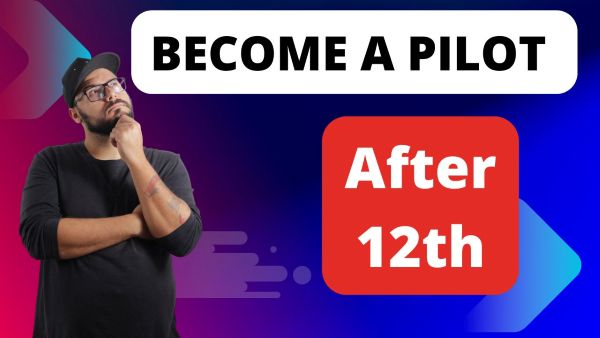Dreaming of a career in aviation? Discover how to become a pilot after 12th in India with this step-by-step guide! Whether you’re a science student with Physics and Mathematics or from a non-science stream, this roadmap covers eligibility criteria, DGCA-approved training programs, flight hours, and licensing processes to help you earn your Commercial Pilot License (CPL). From choosing the right flying school to understanding costs and career opportunities, we break down everything you need to soar the skies and launch your aviation journey!
Embarking on a career as a pilot in India is an exciting journey that demands dedication, academic rigor, and a passion for aviation. Below is an in-depth, step-by-step breakdown of the process, tailored to help aspiring pilots navigate the pathway from high school to the cockpit.
1. Eligibility Criteria: Laying the Foundation
To qualify for pilot training, candidates must meet specific educational, medical, and age-related requirements.
- Academic Qualifications:
- Complete 12th standard (or equivalent) with Physics and Mathematics as core subjects. While some institutions accept a minimum of 50% aggregate marks, competitive flying schools may require higher scores.
- Students from non-science streams (e.g., Commerce or Arts) can still pursue aviation by reappearing for Physics and Mathematics via the National Institute of Open Schooling (NIOS) or state boards.
- Medical Fitness:
- Obtain a Class 2 Medical Certificate from a DGCA-approved medical center. This assessment evaluates vision (6/6 with or without correction), hearing, cardiovascular health, and mental fitness.
- For airline roles, a Class 1 Medical Certificate (more stringent) is required later.
- Age Requirement:
- The minimum age to enroll in a Commercial Pilot License (CPL) program is 17 years, though flight training can only commence at 18. There’s no upper age limit, but airlines often prefer candidates under 30 for entry-level roles.
2. Pilot Training: Building Skills and Expertise
Enrolling in a structured training program is critical to acquiring technical knowledge and hands-on experience.
- Selecting a Flying School:
- Choose a DGCA-approved flying school to ensure compliance with national standards. Top institutions include Indira Gandhi Rashtriya Uran Akademi (IGRUA), Bombay Flying Club, and National Flying Training Institute (NFTI).
- Consider factors like fleet quality, instructor experience, placement records, and costs (training may range from ₹25–40 lakhs).
- Ground Training:
- Theoretical coursework covers aviation subjects such as:
- Aerodynamics and aircraft systems
- Navigation and meteorology
- Air regulations and air traffic control procedures
- Flight planning and aviation safety
- Students must pass DGCA-written exams in these subjects to progress.
- Theoretical coursework covers aviation subjects such as:
- Flight Training:
- Accumulate 200 hours of flight time (minimum for CPL), including:
- Dual flying: Training under an instructor.
- Solo flights: Independent flying to build confidence.
- Cross-country navigation: Long-distance flights across multiple airports.
- Simulator Training: Modern schools use advanced simulators to practice emergencies, instrument flying, and adverse weather scenarios.
- Accumulate 200 hours of flight time (minimum for CPL), including:
3. Licensing and Certifications: Climbing the Aviation Ladder
Pilots must obtain sequential licenses, each unlocking new opportunities.
- Student Pilot License (SPL):
- Issued after clearing a written exam on air regulations and aviation meteorology. Valid for 24 months, it permits flight training under supervision.
- Private Pilot License (PPL):
- Requires 60 hours of flight time (40 solo). A PPL allows non-commercial flying (e.g., recreational or personal travel).
- Commercial Pilot License (CPL):
- Mandates 200 flight hours and clearing DGCA theory exams. A CPL enables paid roles, such as charter or cargo operations.
- Candidates must also pass a Radio Telephony Operator’s License (RTOL) exam to communicate with air traffic control.
- Type Ratings:
- After CPL, pilots undergo aircraft-specific training (e.g., Airbus A320 or Boeing 737) to fly for airlines.
How to Become a Doctor After 12th: A Step-by-Step Guide
4. Career Pathways: Soaring into the Industry
With a CPL, diverse aviation roles become accessible:
- Airline Pilot:
- Join domestic or international airlines as a First Officer, progressing to Captain after accruing experience.
- Entry often requires clearing airline-specific exams, simulator tests, and interviews.
- Corporate Aviation:
- Fly private jets for corporations or high-net-worth individuals, offering flexible schedules and premium salaries.
- Flight Instruction:
- Certified Flight Instructors (CFIs) train future pilots, combining flying with mentorship.
- Cargo Operations:
- Airlines like Blue Dart or DHL hire pilots for freight transport, often with competitive pay and unconventional hours.
- Government/Defense Roles:
- Explore opportunities with the Indian Air Force or Coast Guard through exams like NDA/CDS.
5. Financial Considerations and Scholarships Become a pilot after 12th
- Pilot training is capital-intensive, but financial aid options include:
- Education loans (secured via banks like SBI or HDFC).
- Scholarships from organizations like The Air India Engineering Services Ltd. (AIESL) or flying clubs.
- Sponsorships from airlines in exchange for service commitments.
6. Challenges and Tips for Success
- Stay Resilient: Weather delays, exam pressure, and rigorous training demand perseverance.
- Network Actively: Attend aviation seminars and connect with professionals via LinkedIn.
- Prioritize Safety: Cultivate a mindset focused on risk management and continuous learning.
Conclusion:
Becoming a pilot after 12th is an achievable and rewarding career goal for those passionate about aviation. By following the structured path of meeting eligibility criteria, enrolling in DGCA-approved training, and dedicating yourself to mastering flight theory and practical skills, you can earn your Commercial Pilot License (CPL) and unlock opportunities in airlines, cargo operations, or corporate aviation. While the journey demands perseverance, financial planning, and rigorous preparation, the thrill of commanding an aircraft makes every challenge worthwhile. Stay focused on your goal, prioritize safety, and embrace continuous learning to soar high in this dynamic field. The skies are waiting—start your journey to become a pilot after 12th today!
Also Check Our Latest Uploads
How to Start a Blog and Earn Money: A Step-by-Step Guide (in 2025)


2 thoughts on “How to become a pilot after 12th”